Hyperarousal and Hypervigilance

In the aftermath of sexual violence and assault, the emotional and psychological impact can feel overwhelming. Survivors often face a complex mix of feelings and reactions that may be out of character. Reactions such as hyperarousal and hypervigilance are common experiences and are symptoms of post traumatic stress disorder. 1-3 This contributes to misconceptions and a lack of understanding on how hypervigilance and hyperarousal can impact a survivor’s life. Research shows approximately 70% of individuals who have experienced trauma, including sexual assault, report symptoms of hypervigilance and hyperarousal.4
Hyperarousal
Hyperarousal is when the body’s “fight or flight” response is always active and is characterized by an increased physiological response. Feelings of hyperarousal can have long term mental and physical health impacts where extended periods of hyperarousal can lead to chronic anxiety, insomnia, and irritability.4 Hyperarousal is characterized by feeling jittery, always being on the lookout, general irritability, becoming angry quickly, getting startled by loud noises, paranoia, difficulty sleeping, inability to concentrate or focus on one thing.1-4 These difficulties may be accompanied by accelerated heart rate, elevated blood pressure, shortness of breath, etc. During hyperarousal people tend to be anxious, have difficulty relaxing, and can experience panic attacks.3 Prolonged states of hyperarousal can lead to dysregulation of the autonomic nervous system’s stress response.1
Hypervigilance
Hypervigilance refers to a heightened state of sensitivity to our senses and an exaggerated response to potential threats. Feelings of hypervigilance involve being constantly on guard, feeling perpetually unsafe.1 Hypervigilance is considered a symptom subcategory associated with hyperarousal in the American Psychiatric Association’s handbook for diagnoses (DSM-V). This heightened state of alertness can make it challenging for victim-survivors to engage in normal daily activities without feeling overwhelmed by potential threats. The constant state of alertness can lead to fatigue and a sense of being “on edge” all the time.3
The Impact of Hyperarousal and Hypervigilance
Living in a state of hyperarousal and hypervigilance can be draining mentally and physically. When experiencing these symptoms, people may distance themselves from social interactions and avoid situations that feel potentially threatening, even if they are safe. This can severely impact an individual’s personal relationships and daily functioning. To cope with these challenges, individuals can practice mindfulness and relaxation techniques, such as deep breathing exercises, meditation, or yoga, which help reduce stress and foster a sense of safety. Establishing a supportive network of friends or mental health professionals can provide reassurance and understanding during difficult times.5 Additionally, setting small, achievable goals for social interactions can gradually build confidence and ease feelings of anxiety. Engaging in regular physical activity can also be beneficial, as it helps release built-up tension and promotes overall well-being.
Hypervigilance and hyperarousal are challenging symptoms of PTSD that can profoundly affect the lives of survivors of sexual assault. Understanding these symptoms and their impact is the first step towards compassionately supporting survivors in their healing journey. With the right support and treatment, it is possible to manage these symptoms and improve the quality of life for those affected. Survivors deserve to feel safe and supported as they navigate their path to recovery.
Sources
- Kimble, M., Boxwala, M., Bean, W., Maletsky, K., Halper, J., Spollen, K., & Fleming, K. (2014). The impact of hypervigilance: Evidence for a forward feedback loop. Journal of anxiety disorders, 28(2), 241-245. https://doi.org/10.1016/j.janxdis.2013.12.006
- Dunmore, E., Clark, D. M., & Ehlers, A. (2001). A prospective investigation of the role of cognitive factors in persistent posttraumatic stress disorder (PTSD) after physical or sexual assault. Behavior research and therapy, 39(9), 1063-1084. https://doi.org/10.1016/S0005-7967(00)00088-7
- Dworkin, E.R., Ojalehto, H.J., Brill, C.D., Fitzpatrick, S., Bedard-Gilligan, M.A., Kaysen, D. (2019). Understanding PTSD and Sexual Assault. In: O’Donohue, W.T., Schewe, P.A. (eds) Handbook of Sexual Assault and Sexual Assault Prevention. Springer, Cham. https://doi.org/10.1007/978-3-030-23645-8_17
- Weston, C. S. E. (2014). Posttraumatic stress disorder: a theoretical model of the hyperarousal subtype. Frontiers in psychiatry, 5, 37. https://doi.org/10.3389/fpsyt.2014.00037
- Krupnik, V. (2021). Tackling hyperarousal: an integrative multimodal approach. Cognitive Neuropsychiatry, 26(3), 199–212. https://doi.org/10.1080/13546805.2021.1907177



